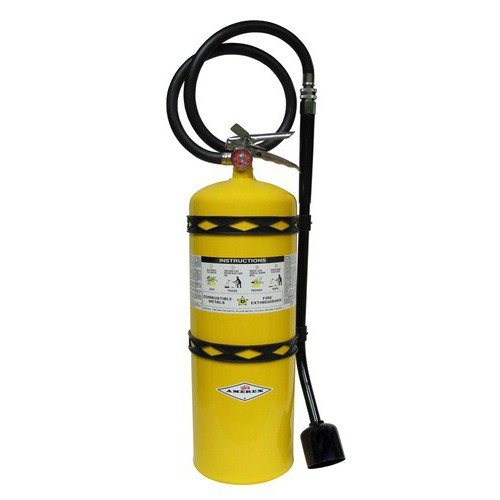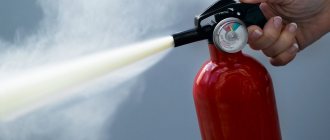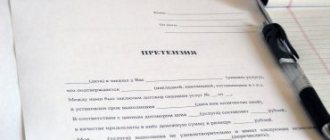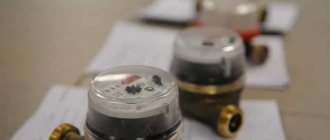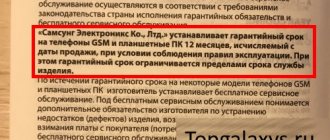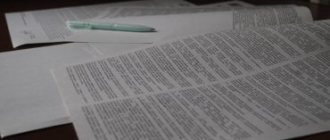20.04.2020
Any residential and non-residential premises, as well as vehicles, must be equipped with fire extinguishers. When a fire occurs, this fire-fighting equipment helps put out the flames in a matter of seconds. There are different types of fire extinguishers, which differ in technical characteristics and features of use in emergency situations. The service life of an individual device also varies. How to identify an expired fire extinguisher and what to do with it in the future is described in detail in the article.
How to determine the expiration date of a fire extinguisher
To determine the expiration date of any type of fire extinguisher, you need to use one of the following options:
- The manufacturer applies a special label to the device body, on the extreme side of which there are Arabic and Roman symbols. Roman symbols indicate the month, and Arabic symbols indicate the year of manufacture of the product. Those numbers on which a small piece of the label is carefully torn off serve as the starting point for calculating the service life.
- The fire extinguisher comes with a passport. In it, the manufacturer indicates the date the device was filled with fire extinguishing agent.
- The date of release, commissioning and refilling of the cylinder is recorded in a special journal for recording fire extinguishing agents. Based on this information, repair periods are monitored and timely recharging, inspection, as well as partial or complete replacement of the product with a new one are carried out.
ATTENTION! Any type of fire extinguisher must be inspected at least once every three months. The countdown begins from the date the cylinder is put into operation. In workshops, warehouses and large industrial enterprises, these actions must be recorded with appropriate notes in a separate journal.
What is fire extinguisher maintenance and why is it needed?
According to the rules developed by the Ministry of Emergency Situations, protective equipment must be stored in certain places and inspected regularly. The main thing is to use the devices for their intended purpose. A fire extinguisher is a complex device, the presence of which is mandatory in the premises (offices, commercial buildings, private apartments) and in the car, that is, wherever a fire may occur. All data relating to the device: its external characteristics, dimensions, as well as the inspection schedule are recorded in special documents. This allows you to monitor the status of the device.
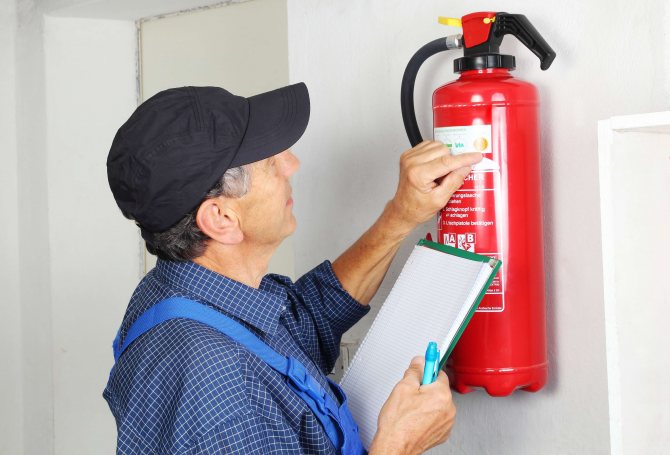
Equipment Study
Maintenance (MOT) of fire extinguishers is a set of measures, including ensuring proper storage conditions, inspection, timely recharging, diagnostics and repairs as necessary. They must be carried out separately for each device. This procedure is necessary to maintain the performance of protective equipment so that they retain their beneficial properties. Fire extinguishers are used more often than hoses in firefighting. Sometimes the life and safety of people depends on the functionality of the device.
Important! A faulty device can become dangerous. It contains special substances under pressure. It cannot be ignored.
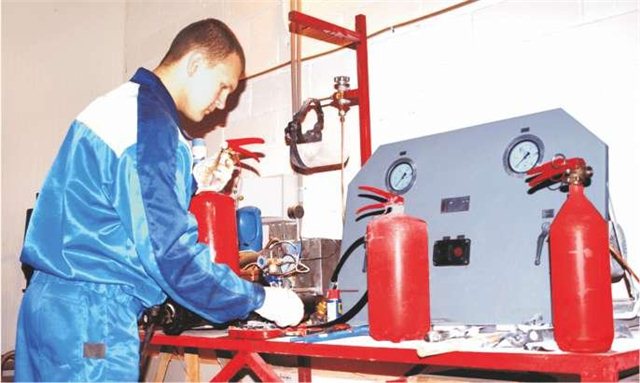
Carbon dioxide level research
Types of fire extinguishers and their service life:
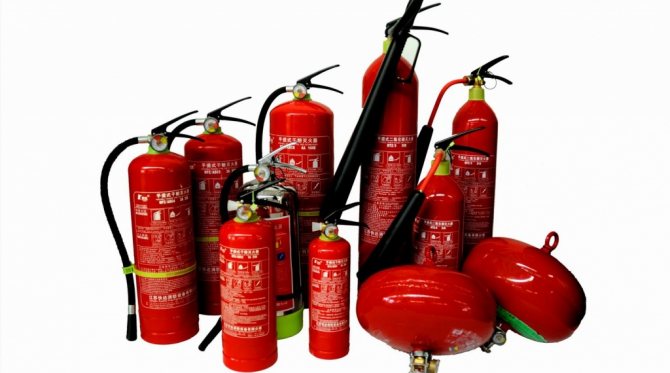
Service life of powder fire extinguishers (OP)
Depending on the powder used in the fire extinguishing agent, which is used as a fire extinguishing agent, its service life is determined. There are three types of powder fire extinguishers:
- Downloads . Their work is that an inert gas pushes out the powder under a certain pressure. Mainly nitrogen and carbon dioxide are used, less often air.
- Gas generators . The cylinders are filled with powder, and a special gas capsule distributes the pressure.
- Self-acting . The devices are filled in advance with powder and gaseous substances so that, under the influence of high temperatures, they begin to operate independently and extinguish the source of fire.
Pressure checks should be performed at least once a quarter. In this case, the result is noted in the fire-fighting equipment registration log. A major inspection and certification is carried out every five years. Powder fire extinguishers, regardless of type, are subject to mandatory testing for the quality of the substance contained inside. From the entire batch, in the amount of 3% of its volume, prototypes are taken. For example, if an institution has 100 fire extinguishers, then any three are subject to inspection.
The shelf life of OP directly depends on the quality and labeling of the powder used:
- PSB-3M . It can be stored for no more than 4 years and is suitable for eliminating fires of fire hazard class B and C.
- Wexon-ABC . Shelf life – 5 years. Suitable for extinguishing class A, B or C fires.
- Foscon . Can be stored for no more than 10 years and is used to prevent fires of fire hazard classes A, B, C and E.
Powder fire extinguishers intended for transportation in vehicles are recharged once every 3 years and serve, according to standards, no more than 10 years. Although they may remain serviceable for a long time, it is not recommended to use such cylinders in order to prevent the spread of fire.
Service life of carbon dioxide fire extinguishers (CO)
According to the standard, stable pressure must always be present inside the cylinder of carbon dioxide fire extinguishers. This is due to the fact that carbon dioxide is pumped there in a liquefied state. For these purposes, there are a number of requirements that must be observed in enterprises and workshops:
- checking devices for pressure, taking into account a small deviation from the norm (up to 5%), at least once a quarter;
- annual technical condition inspection;
- mandatory recharging of the cylinder once every five years (it does not matter whether the pressure remains inside or not).
REFERENCE! The OS can last up to 15 years. Regardless of this period, it is recharged every 5 years. The procedure is carried out by weighing the fire extinguisher and comparing the displayed values with the data entered in the passport. Recharging must be carried out when the value deviates by more than 5%. If after 15 years the pressure remains normal, then the device, despite this circumstance, is taken out of service and replaced with a new one.
Carbon dioxide fire extinguishers used in cars are recharged every 5 years and can be used for up to 20 years in a row.
Service life of emulsion fire extinguishers (EFE)
Expensive fire extinguishers with high operating efficiency. For comparison, we can say that 5 - 7 liters of ORP is equal to 100 liters of ORP. Air emulsion cylinders with a fluorine-containing charge do not need to be recharged. Service life – 10 years . During this time, the EIA does not require a technical inspection.
In most cases, recharging the OVE is quite problematic. Moreover, this procedure is not cheap. Therefore, such fire extinguishers are considered disposable. After 10 years they must be replaced with new ones. The maximum service life is observed at temperatures from -40°C to +50°C.
Shelf life of refrigerant fire extinguishers (OH)
Freon fire extinguishers are a type of gas primary fire extinguishing agent. Their shelf life is the same as that of OU. The exception is some freons, which have an increased corrosive effect. In relation to them, the fire extinguisher label indicates its expiration date.
IMPORTANT! The charge efficiency duration is more than 5 years. But for safety reasons, gas, regardless of the established period, is renewed after the expiration of the period indicated on the label.
Service life of foam fire extinguishers (ORP and OHP)
The expiration of the prescribed shelf life of foam units occurs, as a rule, due to the occurrence of serious corrosion formations at the joints and on the body of the fire extinguisher. Metal oxidation occurs under the influence of water and foam. Checking of redox potential and chemical hazards is carried out once a quarter without fail, with entry into the fire extinguisher logbook.
In relation to foam fire extinguishers, the following actions are carried out:
- Testing for corrosion processes. If during the inspection areas with rust are identified, then such a unit is sent for repair and recharging.
- Replace with a new ORP or OCP once a year. Even if during the year the fire-fighting equipment has retained its original condition and no traces of corrosion are found on its body, it is nevertheless subject to write-off.
Foam devices cannot be recharged, since the internal planes of the cylinder are immediately corroded by moisture and cannot be restored. The shelf life of ORP and OCP is unchanged and is exactly one year from the date of commissioning.
For water fire extinguishers (WF)
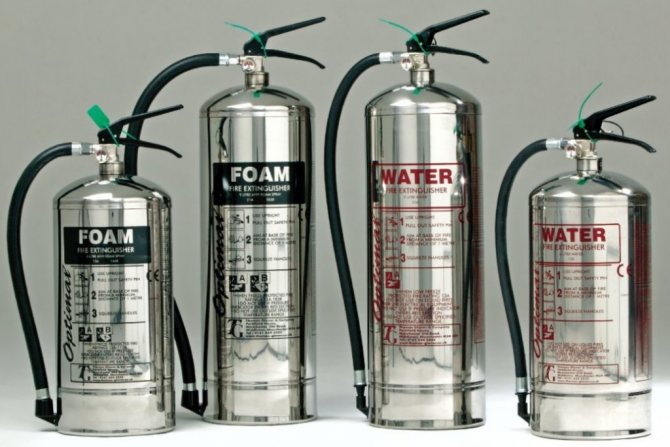
Water fire extinguishers are the most vulnerable to corrosion processes inside and outside the housing. Their service life and maintenance are exactly the same as those of ORP and OCP ( 1 year ). But in fact, they fail much more often than expected, since water strongly corrodes the metal and makes them unusable.
For aerosol (GOA or AGS)
The service life of fire extinguishers marked GOA or AGS is exactly 5 years for conventional models used in residential and non-residential premises, and 2 years for automobile models.
Disposable GOA or AGS are often purchased. Their service life ends after the first fire extinguishing.
What is the shelf life and service life by type and purpose?
Reference. According to GOST R 51017-2009 and GOST R 51057-2001, a fire extinguisher is a portable or mobile device that is necessary to extinguish a fire by releasing a special substance.
The shelf life and storage of fire extinguishers are regulated by a number of regulatory documents:
- SP 9.13130.2009 Fire fighting equipment. Requirements for use.
- NPB 166-97 Fire equipment. Requirements for use.
- GOST R 51057-2001 Fire fighting equipment. Fire extinguishers are portable. General technical requirements. Test methods.
- GOST R 51017-2009 Fire fighting equipment. Mobile fire extinguishers. General technical requirements. Test methods.
- GOST 12.4.009-83 System of occupational safety standards (SSBT). Fire fighting equipment for the protection of objects. Main types. Accommodation and service.
The shelf life of a fire extinguisher depends on its type. All fire extinguishing equipment is divided into two large groups - portable and mobile. They, in turn, are classified according to the following criteria:
- Depending on the fire extinguishing agent (water; air-foam; air-emulsion; powder; gas, including carbon dioxide, freon, combined).
- Based on the principle of gas pressure to displace the fire extinguishing agent (injection; with a high-pressure cylinder for storing compressed or liquefied gas; with a gas-generating device).
- Rechargeable if possible (rechargeable; disposable).
- According to the operating pressure (low pressure fire extinguishers; high pressure fire extinguishers).
- Depending on the type of burning substance or object (solid; liquid; gaseous; metals or organometallic substances; live electrical equipment).
Expiration date of a fire extinguisher according to its type
| Fire extinguisher type | Powder | Carbon dioxide | Freon | Foam and air foam | Air emulsion |
| Portable | 10 years | 10 years | 5 years | 5 years | 10 years |
| Mobile | 10 years | 10 years | 5 years | 5 years | 10 years |
| Transport | 10 years | 10 years | do not use | do not use | do not use |
Powder (OP-4, OP-5 and others)
Important. Powder units are used in cars and trucks (OP-2, OP-3), as well as in industrial enterprises (OP-4, OP-5, OP-8).
They are the most versatile among other types of fire extinguishers, as they are suitable for extinguishing any type of fire.
Let's take a closer look at several types of powder fire extinguishers:
- OP-4 is a portable pump-type fire extinguisher. Used for extinguishing solid, liquid, gaseous flammable materials. Not used for extinguishing materials that can burn in an airless environment. The weight of the charge in the fire extinguisher is 4 kg, its release time is at least 10 seconds. The length of the fire extinguishing powder jet is up to 3 m. The unit operates at temperatures from -30 to +500°C.
- OP-5 – portable fire extinguisher. There are 3 modifications of it - with a cylinder (OP-5(b)), with a gas-generating device (OP-5(g)), injection type (OP-5(z)). All 3 types are used for protection:
- workshops of industrial enterprises;
- warehouse and logistics complexes;
- closed parking lots, parking lots, garages;
- electrical substations, dispatch rooms, control centers, control of production processes;
- technical premises of public and administrative buildings;
- all types of vehicles.
The weight of the charge in the fire extinguisher is 3.9 to 5 kg, its release time is at least 10 seconds. The length of the fire extinguishing powder jet is up to 3 m. The unit operates at temperatures from -40 to +50°C.
Carbon dioxide (OU-3 and others)
Important. Carbon dioxide fire extinguishers are used for urban and railway transport.
The most famous portable devices are the OU-1, OU-3 and OU-10 models, and the OU-25 and OU-80 mobile ones.
Let's take a closer look at the OU-3 fire extinguisher, which is a portable injection-type model. This device is used to protect against fire the following objects:
- industrial and warehouse purposes, administrative and public buildings;
- energy enterprises with a large amount of electrical equipment;
- supply, distribution, control wires, cables in combustible braiding, insulation;
- control centers, dispatch rooms, control rooms;
- archives, banks, museum and exhibition complexes;
- cabins, vans, vehicle chassis;
- railway, passenger, freight cars, electric locomotives;
- sea and river vessels.
The weight of the charge in the fire extinguisher is 3 kg, its release time is at least 8 seconds. The length of the fire extinguishing powder jet is up to 3 m. The unit operates at temperatures from -40 to +50°C.
Khladonov
Refrigerant appliances are used for extinguishing:
- electrical equipment under voltage not exceeding 0.38 kV;
- objects with valuables or expensive equipment;
- Vehicle;
- fires of petroleum products, paraffin, alcohol, glycerin and gaseous substances.
The most used models are OX-2, OX-3, OX-6.
Foam and air-foam
Two types of equipment are used to extinguish small solid and liquid fires.
Important! Foam and air-foam fire extinguishers are prohibited for use on electrical installations.
Portable air-foam devices are represented by models ORP-4, ORP-8, ORP-10, mobile ones - ORP-40, 50 and 100.
Air emulsion
This type of fire extinguisher is the most expensive, since air-emulsion units are the most effective in extinguishing fires among other types of devices.
Air emulsion units consume less fire extinguishing agent (about 5-7 liters) than, for example, a powder device (100 liters) on a fire area of the same size.
Portable air emulsion units are represented by models OVE-2 - OVE-6, mobile - OVE-10, OVE-20, OVE-40, OVE-50.
Is it possible to use an expired fire extinguisher?
Due to safety precautions, an expired fire extinguisher of any type must not be used. Automotive fire extinguishing devices with expired service life may cause the vehicle to fail a technical inspection. The use of expired fire extinguishers is potentially dangerous due to the following circumstances that may arise when it is necessary to extinguish a fire:
- failure and impossibility of its operation;
- change in effectiveness due to loss of fire extinguishing agent properties.
REFERENCE! Expired fire extinguishers can be used as a training tool. Such cylinders are used for training in fire classes and at enterprises when studying safety precautions and practicing fire extinguishing skills.
Fire safety standards prohibit the presence within the walls of an enterprise or institution of any type of fire extinguisher that has expired and has not passed mandatory inspection.
Types of fire extinguisher inspections
The procedure begins from the moment of purchase and installation of the device at the place of its permanent storage.
Frequency of recharging fire extinguishers: application, acts
Maintenance of fire extinguishers consists of a thorough visual inspection of the device. Simply put, this is a comparison of the data indicated on its label with the information in the passport:
- complete set;
- no external damage or scratches;
- The locking and trigger mechanism is sealed, the information there is written legibly.
Then control weighing is performed. Any sensitive scale will do. If the real weight of the device coincides with the written characteristics, everything is fine.
All data received plus the date of the initial examination must be entered in the journal. The procedure is carried out by a responsible person appointed in advance by the manager.
Fire extinguisher maintenance has its own frequency:
- quarterly inspections;
- annual inspection.
Moreover, in addition to the device itself, it is necessary to study its storage environment, to what extent it meets the stated requirements. If the environment is close to unfavorable, this will affect the overall service life.
Important! After installing new protective equipment, it is worth conducting an introductory session, involving the team. Show people the devices, perhaps together perform an initial inspection, at the same time telling them how to use them.
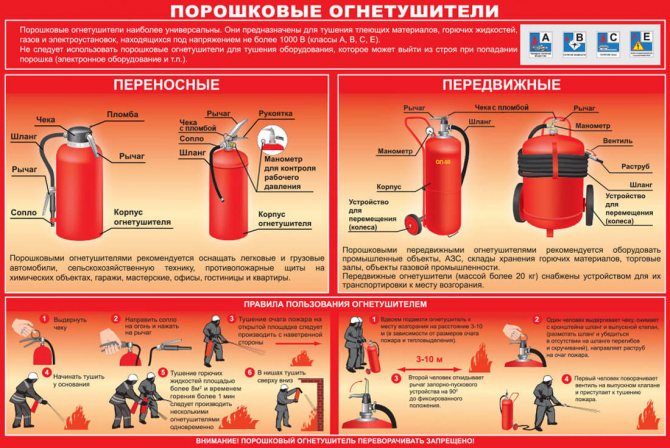
Rules for operating the OP
Quarterly
In meaning and order of action, it is similar to the primary one. The procedure is mandatory; this is done by the person responsible for fire safety measures. He needs to study the documents, visually inspect each device and make an appropriate entry in the journal. If deficiencies are identified, call a technician to make repairs.
Types of actions:
- inspection of the appearance of devices;
- studying documentation;
- examination of the integrity of the filling.
Important! The head of the organization can prescribe unscheduled procedures if circumstances so require. For example, the device was dropped, it “survived” flooding, a short circuit occurred in the place where it was stored, etc.
Annual
Every year it is advisable to invite a specialist who can carry out a professional examination - connect fire extinguishers to special devices in order to identify:
- the amount of substance inside;
- presence of leaks and other malfunctions.
This is done by a professional from a licensed organization. This cannot be detected by eye or by shaking the container.
Full check
Happens every 5 years. This is the most thorough and complete of all procedures, during which:
- Accompanying documents are being studied. They look at how fire extinguishers were checked in general, how often and by whom. How accurate are the written records?
- The specialist discharges all devices, removing the fire extinguishing agent. Then he inspects the fire extinguisher from the inside, examining the integrity of the shell. The functionality of the trigger mechanism is checked by doing practical tests.
- All detected violations, even minor ones, are eliminated. The specialist evaluates the scale of the work itself. If repair is possible, the devices are repaired; if not, it is advised to destroy the faulty device and replace it with a new one.
Re-examination is periodic. Old devices are being updated.
Note! The duration of the procedure is the same and does not depend on the type of device and its additional properties. Thus, the inspection frequency for powder fire extinguishers is identical to other types.
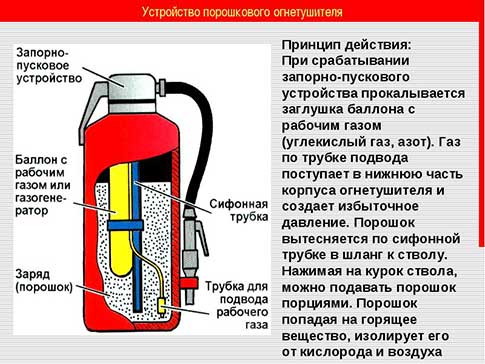
Internal structure of a fire extinguisher
What to do with an expired fire extinguisher
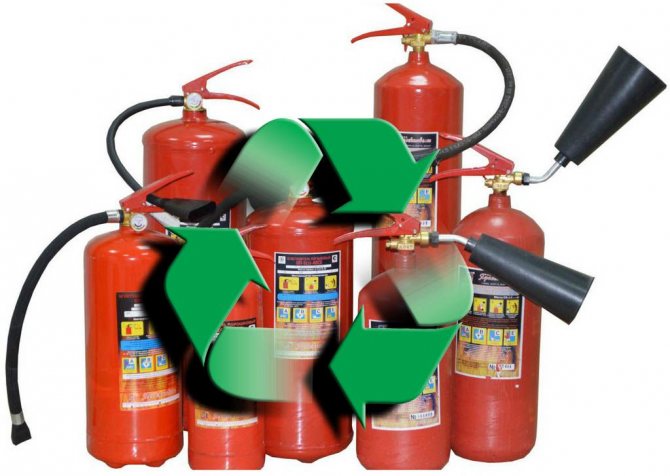
Throwing away fire extinguishers is prohibited by law. The requirements of regulatory legal acts establish the procedure for writing off expired equipment in such a way as not to pollute the environment. Cylinders that are unsuitable for use must be disposed of and the substance contained in them must be regenerated.
Regeneration occurs by carrying out certain technological procedures aimed at converting the substance into the original one. The fire extinguishing composition completely restores its original properties and becomes suitable for refilling working fire extinguishers.
After disposal of the composition contained in the fire extinguisher, its properties completely change. For example, such a converted substance can be used as a fertilizer. Depending on the composition of the utilized substance, it is converted as follows:
- liquid base is used as wetting agents;
- Liquid foaming agents and charges are burned in furnaces or stored in landfills specially designed for these purposes.
It is best to take an unusable fire extinguisher to a recharging station specialist. They will follow all safety regulations when opening high-pressure units. You can scrap the empty cylinder or send it to the nearest collection point for such containers.
ATTENTION! Individuals are not held liable for storing expired fire extinguishers. Legal entities must comply with all legal norms: write off and hand over unusable cylinders to specialized companies for disposal, recycling or regeneration.
How long does it take to check the device and check the contents?
Testing of fire extinguishers and the substances with which they are filled is carried out at a station licensed for this purpose. Since the fire extinguishing agent itself has a shorter service life than the cylinder and it must be changed periodically. All models are subject to recharging after use or when the unit leaks.
- Foam and air-foam fire extinguishers should be inspected and refilled annually.
- Halon fire extinguishing equipment must be recharged every 5 years or more often, depending on the manufacturer's instructions.
- Powder and carbon dioxide units require annual inspection and charging once every 5 years and once every 2 years (for devices installed on vehicles).
- Air emulsion units are refilled once every 10 years.
- Disposable self-triggering devices that are mounted directly above a surface where there is a high risk of fire cannot be recharged.
Regulatory documents on deadlines
The shelf life of any type of fire extinguisher is determined and checked in accordance with regulatory documents, which are guidelines both for the manufacturers of this product and for specialized offices that are directly involved in the maintenance of fire extinguishing equipment.
Regulatory documents in the field of checking the service life of fire extinguishers are:
- SP 9.13130.2009 on requirements for the operation of fire extinguishing devices.
- NPB 166-97. Regulates the use of all types of fire extinguishers.
- GOST 51057-2001 and GOST R 51017-2009. The requirements and routine testing of hand-held and mobile fire extinguishers are outlined.
Deadlines
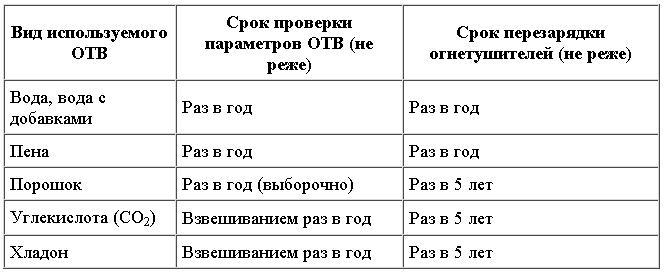
Most often, it is non-compliance with the time intervals for checking, survey, scheduled replacement of the charge, cylinder with a displacing substance that are the reasons for the inoperability of portable (hand-held) or mobile (mobile) fire extinguishers; and not mechanical damage, dismantling of external elements of devices, external contamination.
What is the service life?
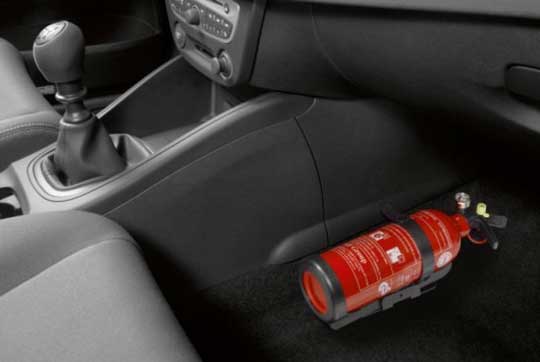
The shelf life of a car fire extinguisher depends on the type of device.
The powder unit can be used for ten years. However, this period only applies to the cylinder itself, and its contents can only be used for five years from the date of production.
Thus, during its service life, the fire extinguisher will have to be recharged once, or after five years you will have to buy a new one.
Carbon dioxide fire extinguisher has a longer shelf life, which is about 15-20 years. However, recharging should also be done every five years.
Storage conditions for carbon dioxide fire extinguishers
The range of possible temperatures for successful storage of such a fire extinguishing agent varies from -41 degrees Celsius to +50. The fire extinguisher must be stored in an easily accessible place and it is important that it is located no further than 1.5 meters from heating devices. It is necessary to limit exposure of the cylinder to direct sunlight. The carbon dioxide fire extinguisher should be checked every six months to identify problems and eliminate them.
When purchasing special equipment, it is important to make sure that the markings are present, you need to check the weight and capacity, charging date, presence of a passport, warranty certificate, etc.
